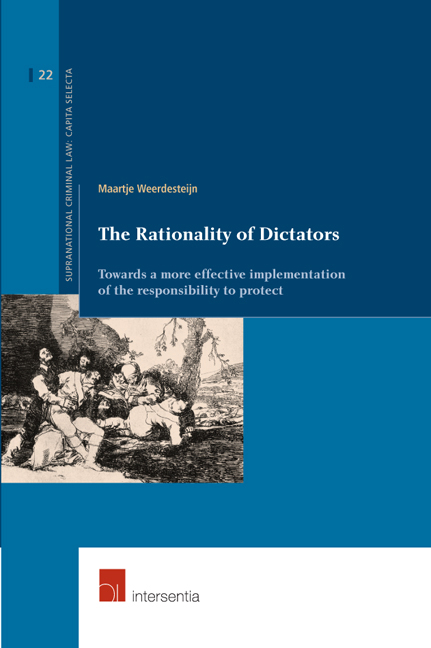 The Rationality of Dictators
The Rationality of Dictators from Part II - The Comparative Case Study
Published online by Cambridge University Press: 28 September 2018
INTRODUCTION
While the previous chapter investigated two case studies that played out before the responsibility to protect was developed and adopted by states, overarching lessons about the manner in which the ideology of a non-democratic leader influences his decision-making process, can be relevant for the future implementation of the responsibility to protect.
As was explained in Chapter 4, the third pillar of the responsibility to protect expressed the preparedness of states to intervene, under Chapter VII of the UN Charter if need be, to protect the population from genocide, war crimes, crimes against humanity and ethnic cleansing when the state in which the crimes occurs is unwilling or unable to do so. Frequently, as we have seen in previous chapters, when mass atrocities have occurred in non-democratic regimes, the dictator actually has orchestrated the violence. He has incited the crimes, legitimized them and formed the institutions that perpetrated the crimes. Under those circumstances, when the dictator plays such a crucial role, intervening under the third pillar often means that the international community needs to persuade the dictator to stop the perpetration of atrocities.
Within the framework of the responsibility to protect and Chapter VII of the UN Charter, peaceful measures are preferred over force in order to achieve the objective, but military intervention should be considered as a last resort. What are the lessons that can be drawn from the interventions in Cambodia and Kosovo for the manner in which the responsibility to protect should be implemented and what implications does it have for the manner in which we study dictators and their rationality? Are these interventions success stories? These are the questions that will be asked and answered in the present chapter.
Firstly, the different choices each of the dictators made will be explained from the perspective of Weber's two types of rationality. Secondly, the rationality of the decision will be differentiated from that of the dictator who took the decision and it will be analysed what role mistakes and misperceptions played in the decision-making process.
To save this book to your Kindle, first ensure [email protected] is added to your Approved Personal Document E-mail List under your Personal Document Settings on the Manage Your Content and Devices page of your Amazon account. Then enter the ‘name’ part of your Kindle email address below. Find out more about saving to your Kindle.
Note you can select to save to either the @free.kindle.com or @kindle.com variations. ‘@free.kindle.com’ emails are free but can only be saved to your device when it is connected to wi-fi. ‘@kindle.com’ emails can be delivered even when you are not connected to wi-fi, but note that service fees apply.
Find out more about the Kindle Personal Document Service.
To save content items to your account, please confirm that you agree to abide by our usage policies. If this is the first time you use this feature, you will be asked to authorise Cambridge Core to connect with your account. Find out more about saving content to Dropbox.
To save content items to your account, please confirm that you agree to abide by our usage policies. If this is the first time you use this feature, you will be asked to authorise Cambridge Core to connect with your account. Find out more about saving content to Google Drive.